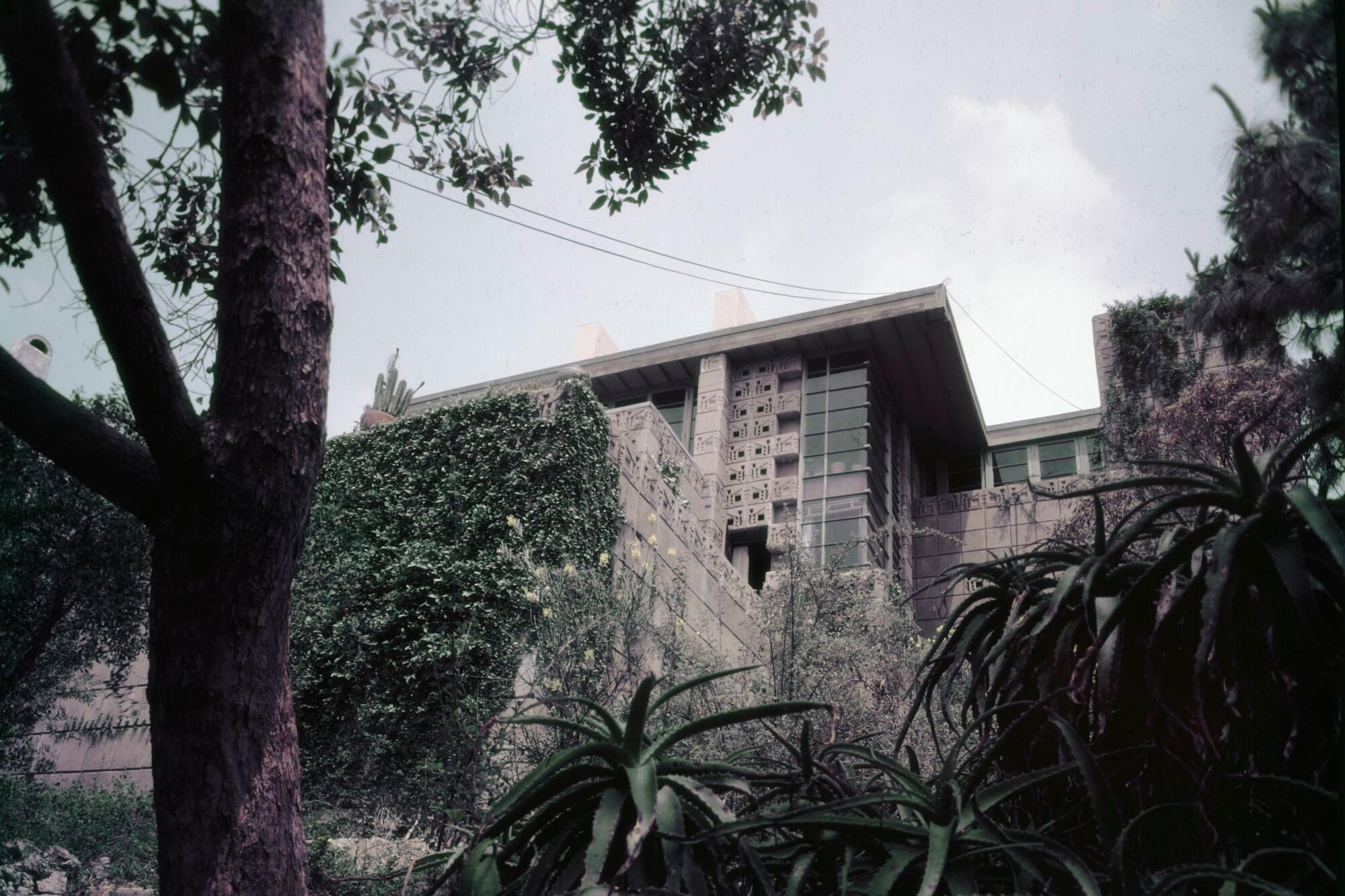
In 1986, Harriet Press Freeman bequeathed to USC’s School of Architecture the home that she and her husband, Samuel Freeman, had commissioned for themselves back in the ’20s.
This was no ordinary house. The 2,800-square-foot structure in the Hollywood Hills had been designed by Frank Lloyd Wright and over the course of its life served as one of L.A.’s more storied bohemian centers: The site of salons that attracted figures such as photographer Edward Weston, bandleader Xavier Cugat and choreographer Martha Graham, it was also a sanctuary to left-leaning artists during the political excesses of the McCarthy era.
There was also the nature of the structure itself. As one of four textile-block homes designed by Wright in the Los Angeles area in the ’20s, its individual blocks were crafted from a mix of sand and Portland cement and embossed with a pre-Columbian-style motif. The Freeman House doesn’t stand on the land so much as it emerges from the hillside like an earthen temple.
But, like many Wright structures — especially those built out of textile blocks — its maintenance has been a never-ending series of challenges. The roof leaked. Rain soaked the fragile blocks, which began to flake and crumble. Rust chewed away at the steel armature around which the blocks had been assembled. In 1994, the Northridge earthquake shifted the home’s foundation, cracking walls and knocking out a chimney. A FEMA grant of $901,000, along with $1.5 million in funds raised by USC, paid for structural repairs. But plans for a full restoration of the deteriorated façades and other damaged elements stalled. For a time, it seemed as if the Freeman House was destined to sit in a permanent state of dilapidated half-repair.
That could be about to change.
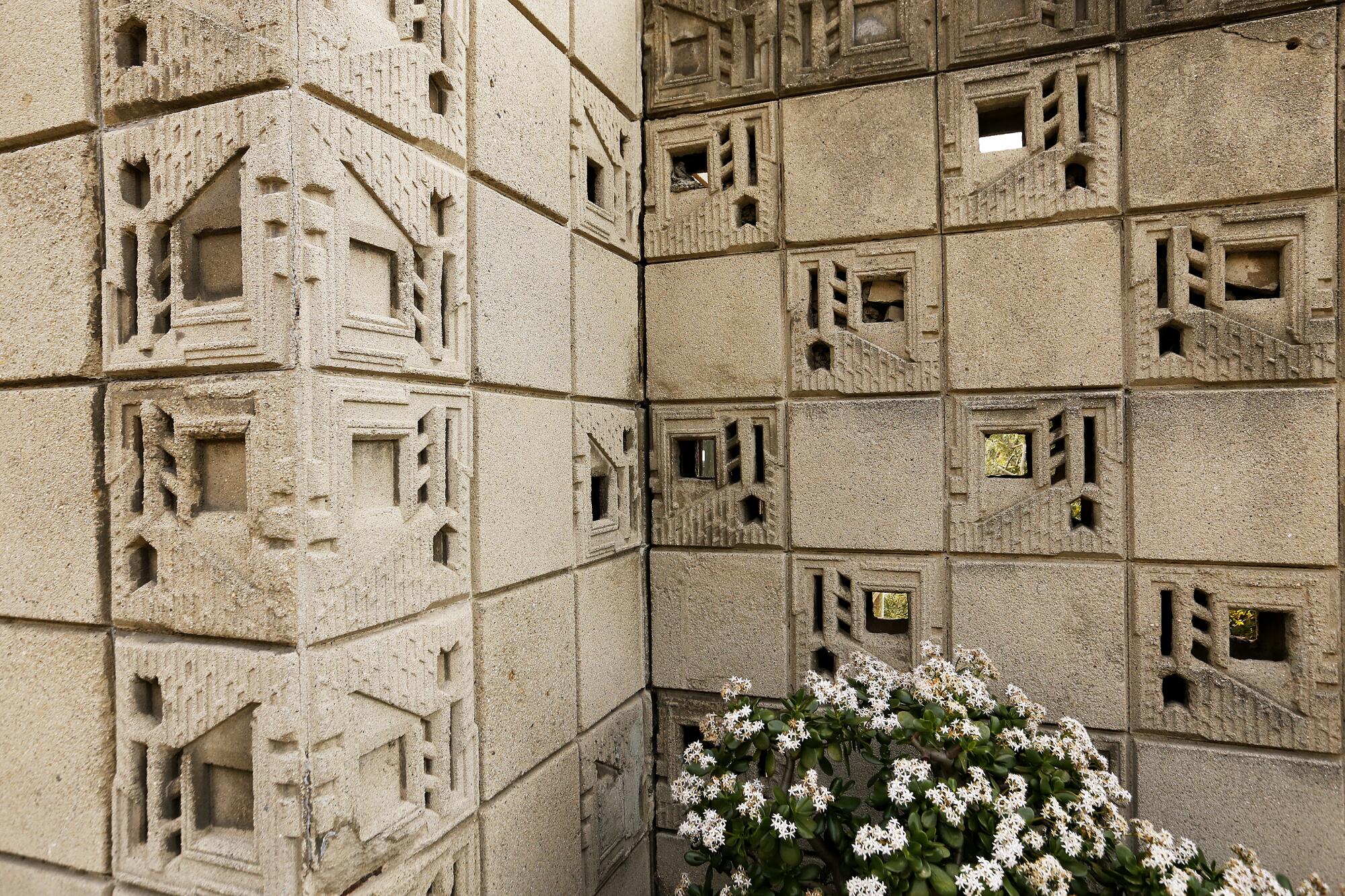
On Thursday, USC announced that it had finalized the sale of the home to Richard E. Weintraub, president and CEO of the Weintraub Real Estate Group, a Los Angeles developer who has worked with historic properties in the past. (He and fellow developer Tom Gilmore helped bring the old St. Vibiana Cathedral in downtown L.A. back to life as a restaurant and events center.)
The university had put the house on the market back in July for $4.25 million, then knocked the price down to $3.25 million. But Weintraub says he was able to acquire it for $1.8 million due to the extensive repairs that are still needed.
It’s a deal that comes with plenty of conditions: in the form of a conservation easement held by the Los Angeles Conservancy that prohibits Weintraub or any future buyer from demolishing the building or making unsympathetic additions. Moreover, as part of the deal, the public — in the form of educational groups or architectural tours — will have access to the home four times a year. (A similar easement governs the Ennis House in Los Feliz, another of Wright’s textile-block homes.)
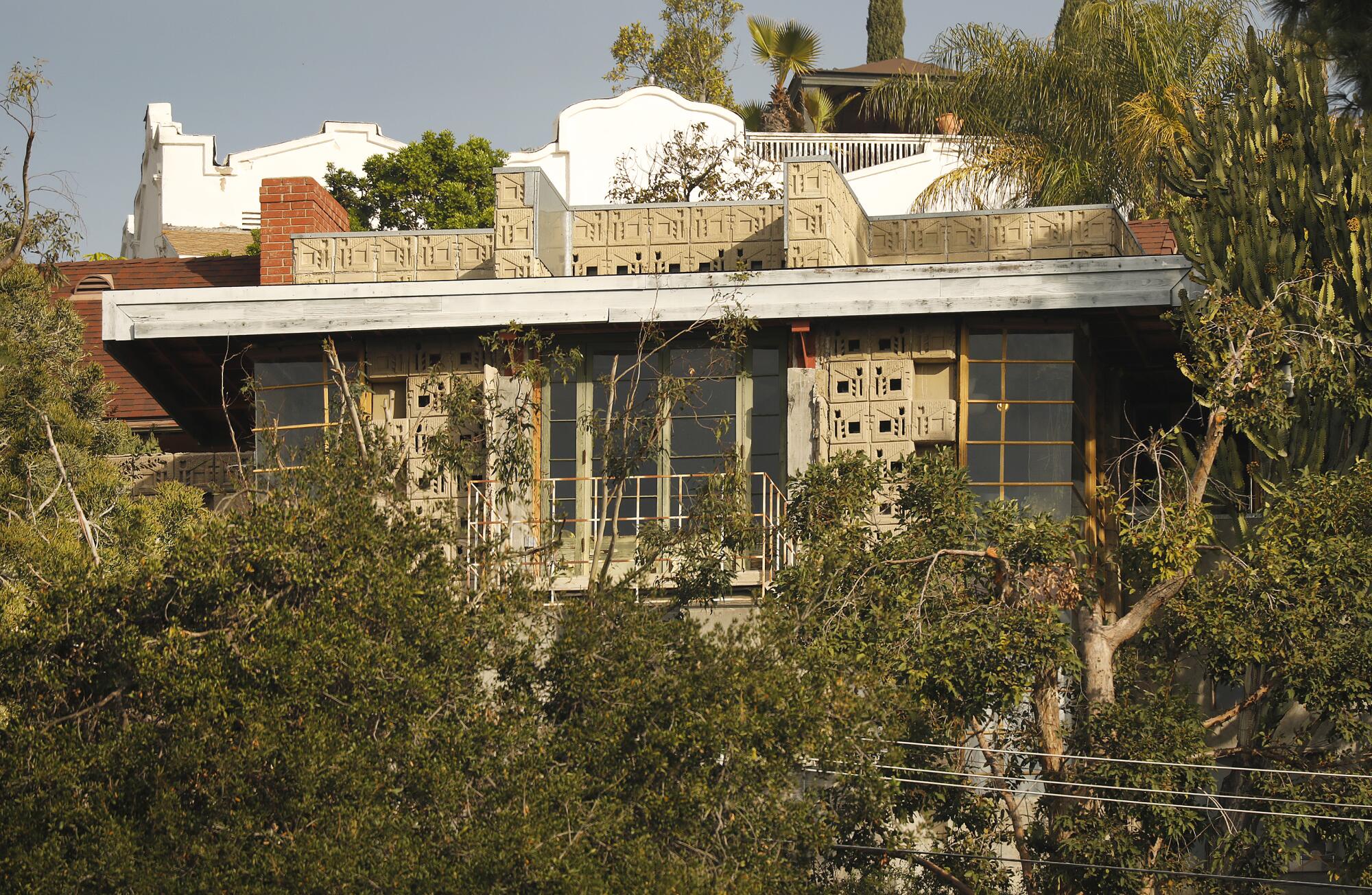
For Weintraub, the acquisition is part of a long-running interest in early 20th century design. “I’m passionate about architecture,” he says. “That was what I wanted to be.”
And he has long found himself intrigued by the images celebrated architectural photographer Julius Shulman took of the Freeman House in the early 1950s (images that now reside in the collections of the Getty Research Institute). “I’ve had it indelibly set in my head — that Julius Shulman image of the window looking out over Highland,” Weintraub says. “It’s a house that hangs over the apex of Hollywood, right off the Hollywood Bowl and the cacophony of the old speakeasies.”
For USC’s School of Architecture, the sale of the Freeman House marks a continued shift away from the stewardship of private homes. In 2019, the university relinquished control of the landmark Gamble House in Pasadena, ceding oversight to the independent Gamble House Conservancy. That same year, plans for the university to receive Arroyo del Rey, a 1979 Pasadena home designed by Case Study architects Conrad Buff and Donald Hensman, as a bequest abruptly fell through.
“The School of Architecture is reaffirming its mission and priorities, which is academic teaching and research,” says the school’s dean, Milton S.F. Curry.
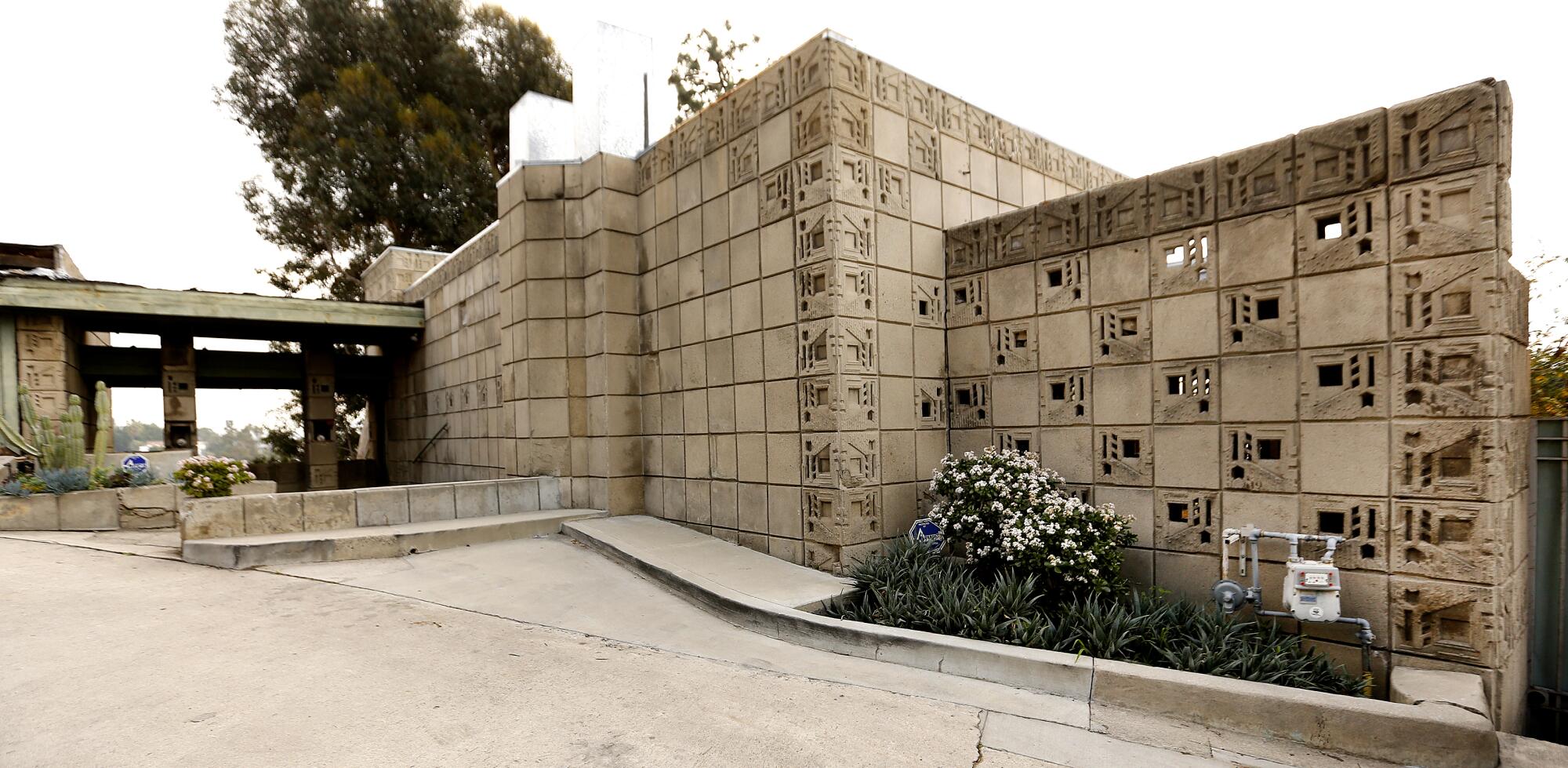
Commentary: The Freeman House, now owned by USC, is in dire need of repair. The school, which is in a disagreement with FEMA over restoration money, has neglected it.
The sale of the Freeman House ultimately removes a preservation job that ended up being bigger than USC could handle.
In a 1998 report, Nicolai Ouroussoff, then The Times’ architecture critic, described the stasis that had enveloped conservation efforts in the wake of the Northridge quake. “Wright’s creation looks ominously fragile,” he wrote at the time. “Along the façade, concrete blocks are cracked or have crumbled away. Wood supports brace the fragile exterior side walls. A heavy canvas tarp is propped, tent-like, over the roof — a necessary prophylactic because the structure leaks. It is a depressing sight.”
USC ultimately was able to gather the necessary funds from FEMA and private donors to repair the home’s structural issues — a significant achievement. But not without Robert Timme, who then served as dean of the School of Architecture, admitting publicly that the school would consider selling the house to anyone who could fix it. (A provision in the bequest allowed for the sale of the home.)
In 2019, the Freeman House made headlines once again when The Times reported that thieves had made off with two lamps and a chair from the home’s cache of furniture, which was being stored in an unmarked warehouse in South Los Angeles. The theft, which had occurred half a dozen years prior — before Curry took over as dean — had gone unreported.
“While USC did do the structural work and used it in a creative way with its architecture school,” says L.A. Conservancy president and CEO Linda Dishman, “they did not have the resources to do what the house needed.
“The textile-block houses, in particular, have very specific conservation needs,” she adds. “There are four in Los Angeles. Each of them have their own issues. These blocks were usually made with ground stone on the site. The amount of cement in the mix of the blocks varies from site to site. It was a very innovative way of building houses, but with innovation, there are issues the architect did not envision.”
Wright, to be unromantic about it, was about form, not function — the kind of architect who often perceived structural engineers as the enemy. The Freeman House, for example, was built without protective flashing on the roof, an aesthetic choice that ultimately contributed to continuous leaks.
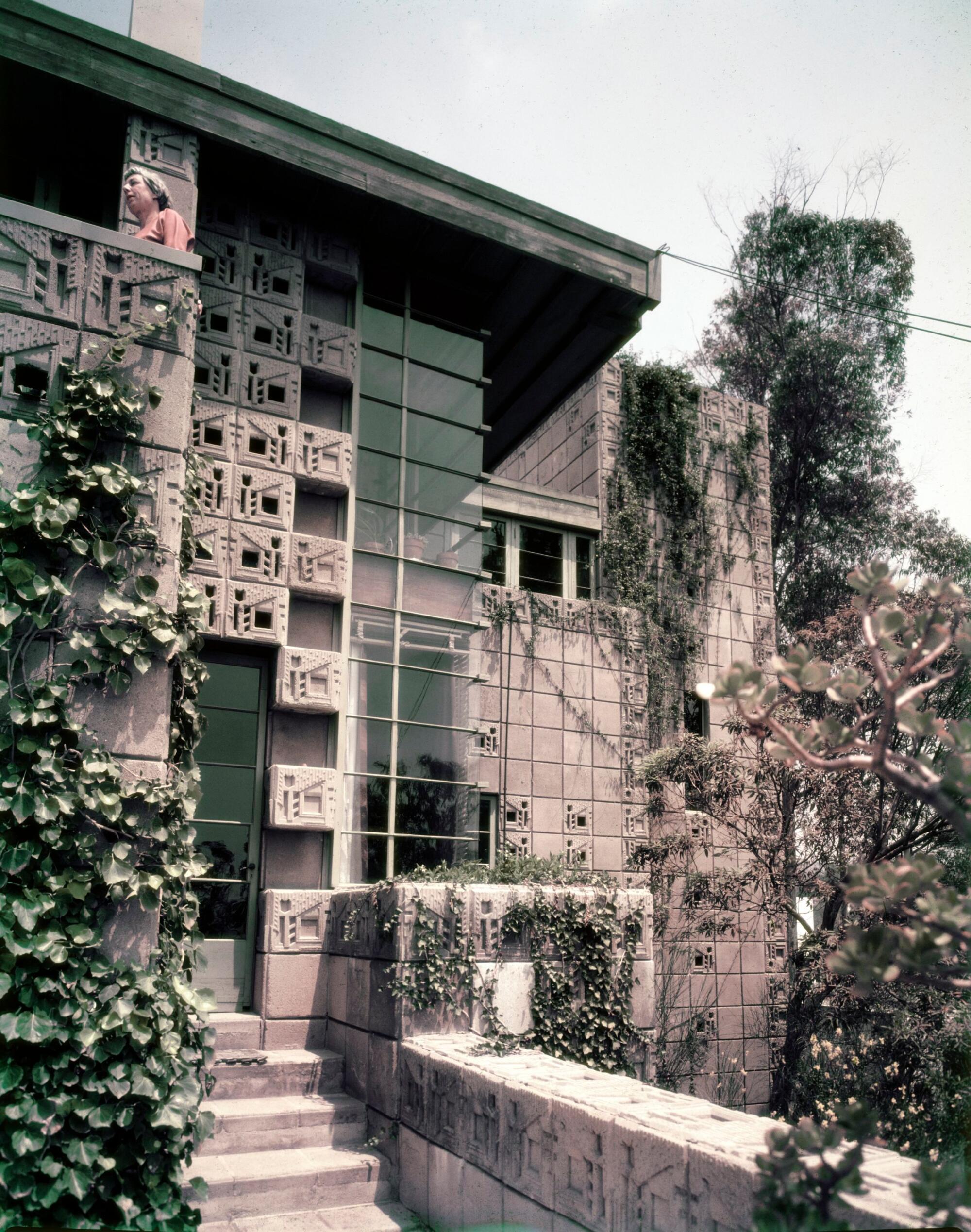
Dishman is pleased with what the sale represents for the home. “USC was very conscious of the fact that they had an architectural treasure. And making their decision of wanting to sell it was in the best interest of the house.”
Jeffrey Chusid, who served on the USC architecture faculty in the 1980s and ’90s and not only was director of the Freeman House but for a time lived in it, agrees that a sale was a good move: “It is an opportunity for new energy and resources to restore this important monument of modern architecture.”
Chusid, who is now at Cornell University and is the author of the 2011 book “Saving Wright: The Freeman House and the Preservation of Meaning, Materials, and Modernity,” says the level of work required at the house was beyond what the university could have provided.
“At the time USC accepted the gift of the house, the extent of the long-term deterioration as well its seismic vulnerability was not clear,” he explains via email from Italy, where he is currently based. “Much of this only became evident as we studied the house, especially following the Whittier earthquake. Then the Northridge earthquake caused extensive damage. From the beginning, the extent of the work required and the cost of fixing the house seemed to grow faster than we could raise the funds.”
Wright’s Ennis House stands as a positive case study for the future the Freeman House may now face. One of the grander textile-block homes, situated on a hill in Los Feliz, the Ennis House also suffered damage in the Northridge quake and was briefly red-tagged as uninhabitable by the Los Angeles Department of Building and Safety in the 2000s after heavy rains destabilized the hillside around the home’s motor court. In 2005, the building was listed among America’s Most Endangered Historic Places by the National Trust for Historic Preservation.
In the wake of that designation, preservationists stepped up. The Ennis House Foundation formed and, with a combination of privately raised funds and a FEMA grant, was able to make necessary structural repairs. But funds required for a full restoration eluded the abilities of the small nonprofit. In 2011, the home was sold to billionaire Ron Burkle, who provided the necessary resources to bring the home back to its majestic 1920s state — with a conservation easement in place that allowed some form of public access 12 times per year.
In 2019, Burkle sold the house for $18 million. The rules of the easement continue to govern the property.
In Los Feliz, billionaire Ron Burkle has sold Frank Lloyd Wright’s famed Ennis House for $18 million, down $5 million from his original price tag.
USC’s School of Architecture, says Curry, remains committed to the study of conservation and preservation — the school, for example, offers a master’s degree in heritage conservation. But, in keeping with contemporary debates about what histories are preserved and how, the school is aiming to reframe what comprises heritage conservation. “Not just wealthy landscapes, “ says Curry, “but cultural communities who are facing gentrification and environmental racism — that reflects the discourse of today.”
Rather than individual houses, the school now is more focused on archives and research. In 2020, the School of Architecture, in partnership with the Getty Research Institute, acquired the archives of Paul R. Williams, a pioneering Black architect whose imprint on Los Angeles was vast even as his designs and his legacy remain wildly understudied. Publications and exhibitions will be forthcoming. In addition, the school launched “Save As,” a podcast led by Trudi Sandmeier, director of graduate programs in heritage conservation at USC, which has explored issues of conservation and preservation in dialogue with social justice, environment and the preservation of intangible cultural assets.
Says Curry: “We remain committed to the ethos of conservation and preservation writ large.”
The first Black architect licensed in California, Paul R. Williams created work that covers the gamut of 20th century architecture.
L.A.’s architectural legacy — so much of which lies in the residential sphere — is certainly a difficult one to preserve, often subject to the vagaries of individual homeowners. Houses are houses, not public buildings, and can therefore be difficult to access or adapt to new uses. They also can be difficult to maintain financially. Historian Andrea Burns published a report on the website of the National Council of Public History in 2015 that synthesized research on the abundant number of house museums in the U.S., noting that their long-term sustainability was “in grave doubt.”
The Freeman House lies at the end of a tight, winding road in the Hollywood Hills — not exactly an ideal location for a truly public site. Which makes its acquisition, by a private buyer who is fascinated by its history and its design possibly the best of all outcomes.
Weintraub — who, incidentally, is a graduate of USC — hopes to find a balance between the private and the public. For now, he does not intend to inhabit the house, but once it is restored, he hopes that it might function as a site for architects- or artists-in-residence, including musicians, composers and dancers. These are traditions in keeping with the home’s history — Harriet Freeman had, at one point, been a dancer. It’s also in keeping with the Weintraub family interests: Weintraub’s wife, Liane Weintraub, a philanthropist and former dancer, helped launch Center Dance Arts at the Music Center and served as its founding chair.
The house, says Weintraub, “has to live the way it lived — it was a salon for intellectual passions. The arts in Los Angeles grew up around it.”
For the sake of L.A. architectural legacy, here’s hoping the Freeman House has finally found its ideal patron.
More to Read
The biggest entertainment stories
Get our big stories about Hollywood, film, television, music, arts, culture and more right in your inbox as soon as they publish.
You may occasionally receive promotional content from the Los Angeles Times.











